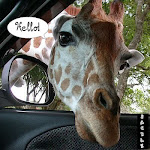
The Monkey way
Hold the banana with the stem pointing downwards.
Pinch just at the tip [gently] to tear the skin (or use your nail).
Peel downwards towards the stem.
Snap Method
Take a banana that isn't overly ripe.
With both hands grasping the banana, make sure the banana is making a u-shape, not a frown shape.
Snap in half, downwards.
Now you have two banana halves which, if done correctly, won't be squished.
Four Splits Method
Take a sharp knife.
Use the very end to split the banana from tip to tip.
Cut the circumference at the middle.
Remove the four pieces.
Throwing Method
Take the banana in your hand and hold onto the long stem in a fist, so that the banana curves towards you.
Thrust your hand(and the banana)outward in a natural motion curving downward.
See the skin just snapped the stem and you can proceed to peel your banana.
Enjoy!
Upside-Down Method
Position the banana so that the stem is down.
Pinch the end of the banana which causes it to split and easily peel
This method is used for under-ripe bananas, as they are difficult to peel from the stem end.It should be noted that bananas grow stem-side-down, so in essence this is the right-side-up method.
Twist Method
Grasp the banana in both hands.
Without squeezing, give the banana a quarter to a half twist, just enough for the skin to break.
Use the break to peel the banana the rest of the way.
The banana ‘story’ continues,
Ecuador warns of new claims
by Chakravarthi Raghavan
Geneva, 26 Sep 2000 - Ecuador, the world’s leading banana producer, threatened Tuesday to take new legal action against the European Union (EU) for financial reparations over the injury caused to Ecuador by the EC’s continued restrictions on the import and marketing of bananas.
The Ecuador representative warned that there could soon be a new Banana IV case at the WTO (the first two were under the old GATT, and the third was where the rulings went against the EC, and which has now become a case of the EC regularly reporting about its efforts to implement a long-overdue implementation).
But neither an unofficial english text of Ecuador’s intervention at the Dispute Settlement Body Tuesday, nor the official briefings indicate what Ecuador would, or could do, in pursuance of the WTO or other general international treaty obligations to get financial reparations.
Ecuador told the DSB Tuesday, when the issue came up under the DSB agenda item about surveillance of rulings and implementation, that on several occasions it had shown great flexibility, even though it had not been reciprocated.
It was Ecuador’s view that the import licensing distribution system to be presented by the Commission to its Council of Ministers will combine the “first-come, first-served” method with a “simultaneous examination”. Ecuador was clear it “shall not include a ‘boat race’ and this aspect should be out of the new system.”
Ecuador would await this new method of license distribution for a brief transitional period (as envisaged by the EC), with a firm commitment to apply thereafter a “tariff only” system.
Outlining the history of the dispute and rulings so far, Ecuador asked: “If there is no movement forward, that is if the EC maintains the current illegal situation, what is there to be done for the banana exporting countries? Does the lack of compliance by the EC actual mean that it has mocked the dispute settlement system of the WTO? Has this lack of compliance exhausted the system reaching the limits where those who have been injured have their rights simply extinguished? Ecuador does not believe this is the case and that is why we should not be surprised by the possibility of starting a new Banana IV case.”
But such a new legal action was a forced step they would have to take, in the face of non-compliance, and the expiry of the waiver for ACP preferences on 29 February. There was thus a non-authorized discrimination violating Article I of the GATT. This, and an examination of the illegal distribution of tariff rate quotas currently applied by the EC.
The new legal action would seek a “just reparation of the injury caused,” Ecuador said.
“General international law on state responsibility requires states not only to terminate any violation of international law, in this case the WTO agreements, but also to permit full reparation of injury, including monetary compensation of damage caused by the wrongful act.”
In Ecuador’s view, a careful reading of Art. 3.2 of the DSU, read along with Art 31.3 of the Vienna Convention on Interpretation of Treaties, “confirms that general international law on state responsibility is applicable for this case.” The responsibility of the EC does not cease by recognising a violation exists. But the EC must also terminate the violation, terminate the cause of injury, and must proceed to repair the injury.
While Ecuador admitted there were different views on how pertinent it was to seek from a panel and from the Appellate Body a finding on this right for reparation of injury, its statement did not make clear how or what the WTO and the DSB could do - since the only remedy envisaged is ‘withdrawal of equivalent concessions’, something that the DSB has already authorized Ecuador to take, but a remedy worse than the disease for any weak trading partner, and as shown in other cases, for the stronger too.
The various GATT and WTO rulings—by panels, Appellate Body, compliance panels, arbitration panels etc—have already ruled against the EU, which purchases 40% of the bananas sold on the world market.
The EU’s trade policy restricts the entry of bananas coming from Latin America, which are largely placed on the European market by US-based transnational corporations.
Europe’s subsidies tend to favour its former colonies of the Africa, Caribbean and Pacific (ACP) group of countries, which produce bananas at a higher cost than the Latin American nations. But the import regime of Europe also favour its own transnationals engaged in distribution, as also production and sale of bananas from the “overseas territories”.
This week, in its latest statement, the European Commission, the EU’s executive body, announced the EU was studying the feasibility of administering the proposed contingent tariffs based on the order in which requests are received.
Ecuador, one of several plaintiffs in the banana claims against the EU, has agreed to accept this system that melds a “first- come, first-served” approach with simultaneous examination.
But the Ecuador government says this mechanism should only be applied during a very short transition period, followed by a new system based solely on tariffs.
Latin America’s banana-exporting countries consider the EU’s import regimen similar to its agricultural subsidy policy, which “seeks to protect inefficiency at the expense of other countries that generally are going to great lengths to escape underdevelopment.”
A study conducted at the request of the World Bank indicates that it costs EU consumers $2 billion to maintain the scant $151 million annual transference for preferred ACP suppliers through the EU’s “banana aid.”
For every dollar spent on banana subsidies, European consumers pay $13.25, according to the Bank’s study by Brent Borrell, of the Australian-based Centre for International Economics.
Though the international banana trade is limited in relation to other commodities, it is the “most negotiated fruit” on the world market and takes on crucial importance for many developing countries.
The countries of the Caribbean in particular have warned that a modification of the European policy would endanger many of their region’s economies, which are mainly, if not solely dependent on the banana economy.
The St. Lucia delegation to the WTO said that imposing a tariff system for the banana trade in Europe could prove disastrous.
In reference to a potential claim by Ecuador for economic damages caused by the European policy, the Caribbean island’s representation stressed that the real question should be “which are the vulnerable countries in this business?”
Earlier, at the DSB meeting Mr. Carlo Trojan, the EU representative to the WTO, affirmed that the Commission would present a proposal for a solution before the bloc’s ministerial council next week.
The EU is not engaging in delay tactics, he emphasised, adding that it genuinely intends to find a solution to the conflict that has already cost the Europeans several adverse rulings and economic sanctions, the latter resulting from cases initiated by the United States and Ecuador.
Guatemala, Honduras, Mexico and Panama supported Ecuador’s position at the DSB.
The Honduran delegation stressed that the solution proposed by the EU would automatically grant import licenses to the ACP countries, and continue the exclusion of Latin American countries from the European banana market
FD: I was going to do an update on the "NEW" Banana
http://www.snopes.com/food/warnings/bananas.asp
Fungus Threatens Banana Crops
Some Experts Believe Bananas May Need Genetic Modification
Aug. 14, 2005
Post a Comment
FONT SIZE
EMAIL
PRINT
RSS
//,summary: ''
var stEntryObj = SHARETHIS.addEntry({
title: document.title},
{button:false});
document.write('SHARE');
var stElement = document.getElementById("shareThisButton");
stEntryObj.attachButton(stElement);
SHARE
The most popular type of banana -- Americans' favorite fruit -- may be threatened by a fungus spreading throughout plantations in Southeast Asia.
According to the International Banana Association, the average American eats more than 28 pounds of bananas a year, compared to just 16 pounds of apples. In addition, the International Banana Association says, more than 96 percent of American households purchase bananas at least once a month.
But an article in the August 2005 edition of Popular Science magazine suggests a fungal disease called Panama Disease Race 4 could threaten the existence of the Cavendish, the most widespread variety of banana sold in markets around the world. Panama Disease Race 4, has been found in Southeast Asia, Australia and Indonesia, and some experts believe it could be only a matter of years before that fungus spreads to Latin America, the United States' main source of its favorite bananas.
In addition, some analysts believe the only way our favorite bananas may be saved from the fungus will be through genetic engineering.
"The only way to save the variety of that we're eating today -- the Cavendish -- is by genetically altering the material through engineering," said Mark Jannot, editor in chief of Popular Science.
Spread of Fungus to Latin America Not Certain
However, the IBA says consumers should feel confident that bananas will be available now and in the future. In a statement, IBA officials said it is not certain that Panama Disease Race 4 will infect the banana crops in Latin America.
"It is far from certain that Panama Disease Race 4 will spread to Latin America," the association said in a statement. "Contamination would have to occur by introducing infected banana plants or infested soil, and quarantine measures and growing practices exist today to minimize those risks. For example, planting material used today is developed with tissue culture techniques, and screening methods exist that detect diseases prior to their release into the environment. Furthermore, it is not fully understood how Race 4 would proliferate in the different soils throughout Latin America and adversely impact the banana growing regions."
http://www.popsci.com/scitech/article/2008-06/can-fruit-be-saved
The banana as we know it is on a crash course toward extinction. For scientists, the battle to resuscitate the world's favorite fruit has begun—a race against time that just may be too late to win
By Dan Koeppel
Can this fruit be saved?
View Photo Gallery
Ed Note: In 2005 Dan Koeppel traveled to Central America to begin his research on the banana—a fruit whose ubiquity, he discovered, may very well prove to be its downfall. His book, Banana: The Fate of the Fruit That Changed the World, was recently published to much acclaim. Here's the feature that started it all.
"A Banana," says Juan Fernando Aguilar, "is not just a banana." The bearded botanist and I are traipsing through one of the world's most unusual banana plantations, moving down row after row of towering plants and ducking into the shade of broad leaves in an attempt to avoid the Central American midday heat. In an area about the size of a U.S. shopping mall, Aguilar, 46, is growing more than 300 banana varieties. Most commercial growing facilities handle just a single banana type-the one we Americans slice into our morning cereal.
The diversity of fruit in Aguilar's field is astonishing. Some of the bananas are thick and over a foot long; others are slender and pinky-size. Some are meant to be eaten raw and sweet and some function more like potatoes, meant for boiling and baking or frying into snack chips. But Aguilar's admonition is aimed squarely at our northern lunch boxes and breakfast tables.
For nearly everyone in the U.S., Canada and Europe, a banana is a banana: yellow and sweet, uniformly sized, firmly textured, always seedless. Our banana, called the Cavendish, is one variety Aguilar doesn't grow here. "And for you," says the chief banana breeder for the Honduran Foundation for Agricultural Investigation (FHIA), "the Cavendish is the banana."
The Cavendish-as the slogan of Chiquita, the globe's largest banana producer, declares-is "quite possibly the world's perfect food." Bananas are nutritious and convenient; they're cheap and consistently available. Americans eat more bananas than any other kind of fresh fruit, averaging about 26.2 pounds of them per year, per person (apples are a distant second, at 16.7 pounds). It also turns out that the 100 billion Cavendish bananas consumed annually worldwide are perfect from a genetic standpoint, every single one a duplicate of every other. It doesn't matter if it comes from Honduras or Thailand, Jamaica or the Canary Islands-each Cavendish is an identical twin to one first found in Southeast Asia, brought to a Caribbean botanic garden in the early part of the 20th century, and put into commercial production about 50 years ago.
That sameness is the banana's paradox. After 15,000 years of human cultivation, the banana is too perfect, lacking the genetic diversity that is key to species health. What can ail one banana can ail all. A fungus or bacterial disease that infects one plantation could march around the globe and destroy millions of bunches, leaving supermarket shelves empty.
A wild scenario? Not when you consider that there's already been one banana apocalypse. Until the early 1960s, American cereal bowls and ice cream dishes were filled with the Gros Michel, a banana that was larger and, by all accounts, tastier than the fruit we now eat. Like the Cavendish, the Gros Michel, or "Big Mike," accounted for nearly all the sales of sweet bananas in the Americas and Europe. But starting in the early part of the last century, a fungus called Panama disease began infecting the Big Mike harvest. The malady, which attacks the leaves, is in the same category as Dutch Elm disease. It appeared first in Suriname, then plowed through the Car- ibbean, finally reaching Honduras in the 1920s. (The country was then the world's largest banana producer; today it ranks third, behind Ecuador and Costa Rica.)
Growers adopted a frenzied strategy of shifting crops to unused land, maintaining the supply of bananas to the public but at great financial and environmental expense-the tactic destroyed millions of acres of rainforest. By 1960, the major importers were nearly bankrupt, and the future of the fruit was in jeopardy. (Some of the shortages during that time entered the fabric of popular culture; the 1923 musical hit "Yes! We Have No Bananas" is said to have been written after songwriters Frank Silver and Irving Cohn were denied in an attempt to purchase their favorite fruit by a syntactically colorful, out-of-stock neighborhood grocer.) U.S. banana executives were hesitant to recognize the crisis facing the Gros Michel, according to John Soluri, a history professor at Carnegie Mellon University and author of Banana Cultures, an upcoming book on the fruit. "Many of them waited until the last minute."
Once a little-known species, the Cavendish was eventually accepted as Big Mike's replacement after billions of dollars in infrastructure changes were made to accommodate different growing and ripening needs. Its advantage was its resistance to Panama disease. But in 1992, a new strain of the fungus-one that can affect the Cavendish-was discovered in Asia. Since then, Panama disease Race 4 has wiped out plantations in Indonesia, Malaysia, Australia and Taiwan, and it is now spreading through much of Southeast Asia. It has yet to hit Africa or Latin America, but most experts agree that it is coming. "Given today's modes of travel, there's almost no doubt that it will hit the major Cavendish crops," says Randy Ploetz, the University of Florida plant pathologist who identified the first Sumatran samples of the fungus.
A global effort is now under way to save the fruit-an effort defined by two opposing visions of how best to address the looming crisis. On one side are traditional banana growers, like Aguilar, who raise experimental breeds in the fields, trying to create a replacement plant that looks and tastes so similar to the Cavendish that consumers won't notice the difference. On the other side are bioengineers like Rony Swennen, who, armed with a largely decoded banana genome, are manipulating the plant's chromosomes, sometimes crossing them with DNA from other species, with the goal of inventing a tougher Cavendish that will resist Panama disease and other ailments.
Banana experts disagree on when the Latin American and African crops will be hit by the Panama fungus. Ploetz won't venture a guess, but he notes that the Malaysian plantations went from full-scale commercial operations to "total wipeout" in less than five years. Currently, there is no way to effectively combat Panama disease and no Cavendish replacement in sight. And so traditional scientists and geneticists are in a race-against one another, for certain, but mostly against time.




































No comments:
Post a Comment